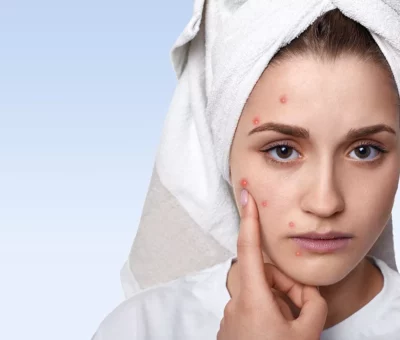Your mood and cravings are not the only things that can be set off by your menstrual cycle. Your complexion is also susceptible to several changes, with oilier skin and acne outbreaks being the most common concerns. According to studies, almost half of women experience premenstrual acne flare-ups.
Changes in your epidermis are caused by hormonal fluctuations. For instance, the decrease and increase of estrogen can affect the texture, fluid balance, and thickness of the epidermis. Changes in hormones can also increase sebum secretion in the epidermis. This can combine with decaying skin cells to clog pores and cause acne breakouts.
Learn more about these hormonal changes and what happens to your epidermis during your menstrual cycle by reading on. We also provide hygiene advice for each phase.
Menstruation cycle
There are other phases of a woman’s menstrual cycle besides menstruation and ovulation. This cycle’s average duration is 28 to 29 days, but it can be as brief as 21 days or as long as 35 days. Typically, the menstrual discharge lasts between three and five days, but it is still considered normal for a period to last from two to seven days.
Menstrual phase (days 1 to 6) – Also known as the period phase, this is when your hormone levels are at their lowest (estrogen and progesterone). This can then cause the skin to feel parched and sensitive, as well as increase the visibility of lines and creases.
Do not scrimp on cleansing and moisturizing your epidermis during this phase. Utilize a skin-type-appropriate, mild cleanser and serums or moisturizers with soothing and hydrating constituents. Those containing hyaluronic acid are the best option.
This phase begins on the first day of menstruation and concludes on the day of ovulation. During this phase, estradiol levels rise, which contributes to the production of collagen, elastin, and hyaluronic acid. This promotes the development of more elastic skin cells and stimulates cell turnover, resulting in a fuller, younger-looking complexion.
To prevent congested pores, you should focus on exfoliating your skin delicately during the follicular phase. To boost the firming and revitalizing effects of exfoliation, you can also use a serum containing vitamin C. Additionally, a potent substance hydrates and nourishes the epidermis.
Before the ovulation phase, your estrogen level increases, resulting in a radiant or luminous complexion. Additionally, an increase in estradiol causes the pituitary gland to emit luteinizing hormone. This results in the ovary releasing its embryo. The egg will perish if it is not fertilized (meets a sperm) during this phase.
In some cases, your skin may become oilier during ovulation, causing breakouts. Just be sure to exfoliate your skin frequently and avoid using heavy products that can obstruct your pores.
Luteal phase (days 17 to 28) – During this phase, progesterone levels rise, helping to prepare the uterine lining for pregnancy. The increase in progesterone can cause your sebaceous glands to produce more oil than usual, resulting in acne outbreaks before your period.
Be sure to bathe your face frequently and use a cleanser containing salicylic acid if acne appears prior to your period. This can help reduce erythema and inflammation and accelerate the healing process. A clay masque can also be beneficial, as it helps eradicate impurities and refine pores.
Promoting skin health
You can learn more about your menstrual cycle and modify your hygiene by using a period tracker. In addition to seeking assistance to identify the most effective treatment, modifying your daily routine can be beneficial.
It is also important to note that not all forms of acne are associated with hormones or the menstrual cycle. Acne affects both sexes, as well as adolescents and adults. In addition to diet, genetics, certain medications, and stress, there are a few other factors that can cause or aggravate acne.
Here are some helpful resources.
Always use broad-spectrum sunscreen (at least SPF 30) when outdoors. Use sunglasses, caps, and protective garments for added safety.
Avoid handling your face and picking and compressing your acne. This will only cause the fluid or bacteria to penetrate deeper into the epidermis, resulting in increased inflammation, dark blotches, and scarring.
Even if you have viscous or greasy skin, avoid over-washing your face. Cleanse your face twice daily and after exercise. Blotting papers can be used to control sheen and oil.
Limit your consumption of sugary, fatty, and uncomplicated carbohydrate-rich foods. Consider avoiding dairy if it aggravates or exacerbates your acne.
Be patient and consistent while using acne medication. It may take between six and eight weeks for your medication to take effect.
Alternate or launder your pillowcases at least weekly. The same holds true for other materials or surfaces that come into regular contact with your epidermis, such as sheets and headwear.
Consult a dermatologist or aesthetician for assistance. They can recommend medications or dietary supplements that can alleviate your symptoms. Additionally, you can consider facial and aesthetic treatments to address other acne-related issues. At Cutis, we offer numerous treatments for acne and its associated symptoms.
VI Peel Purify is a chemical peel designed to treat acne and related issues. In addition to calming irritation and inflammation, it can stimulate cell turnover to unclog pores.
Laser Genesis Skin Therapy — enhances the texture of the skin by treating enlarged pores, skin redness, irregular skin tone, and fine lines. It can be combined with a chemical exfoliation to combat skin imperfections such as acne.
Dermapen 4 micro needling – creates microscopic needle punctures in the upper layer of skin and stimulates the production of collagen. As it stimulates the body’s repair and regeneration processes, it can keep acne under control. Additionally, it can reduce pigmentation and cure acne scars.





Leave a Reply